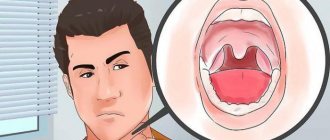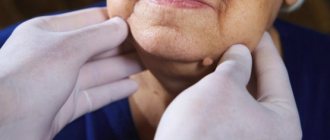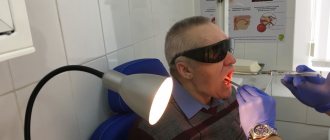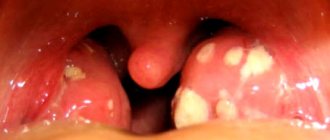Rinsing the lacunae of the palatine tonsils is one of the most common recommendations of doctors who have diagnosed chronic tonsillitis in their patients. Some patients bring themselves to a deplorable state, not wanting to go to the doctor at the first manifestations of alarming symptoms of the acute stage of the disease. Only after it becomes unbearable to endure do patients come for an appointment with an advanced illness. Washing alone will not help in such situations, but in combination with antibacterial medications it will neutralize painful symptoms.
Washing methods
This procedure must be carried out carefully, it is better to have it done by a specialist, since with the wrong approach you can aggravate the situation up to the development of sepsis, driving the inflammatory process even deeper or damaging soft tissues.
Washing of the lacunae of the tonsils is carried out in the following ways:
- Using a syringe for intralaryngeal infusions and rinsing of the tonsils.
- Vacuum rinsing of tonsils with the Tonsilor apparatus.
- Deep rinsing using phonophoresis and ultrasound.
Flushing with a syringe
This method can be offered in any clinic. It is considered painless and lasts about 10 minutes. The patient is seated and asked to open his mouth. A cannula is attached to the syringe. The surface of the pharynx is treated with a solution of local anesthetic. They do this to reduce discomfort during manipulation.
After this, the cannula of the syringe is inserted into the cavities of the tonsils and their contents are sucked out. This can be pus, microorganisms and their metabolic products, food debris, or liquid. After the procedure, the surface is irrigated with anti-inflammatory solutions.
Pus leaks from the tonsils. Pus on the tonsils: causes and signs
Purulent plugs on the tonsils are a sign of purulent tonsillitis!
The cause of pus on the tonsils is tonsillitis (or acute tonsillitis). The causative agents of this disease are bacteria, which lead to the formation of pus. There are many opinions about how to squeeze pus out of tonsils and whether it is worth doing it yourself. Tonsils are accumulations of lymphoid tissue; they perform a protective and barrier function. When pathogenic microorganisms enter, the tonsils do not allow them to pass further into the respiratory tract. The very fact of the formation of pus indicates that the protective function of the tonsils is impaired.
Pus plugs are only a symptom and not the cause of the disease, but they must be removed. Cleansing the tonsils from pus brings almost instant relief, the temperature drops, swelling and sore throat decrease. For this reason, local treatment is very important for sore throat. Pus may not form immediately, but only with frequent colds and sore throats. The more often a person gets sick, the more severe the disease and the higher the risk of complications. The cause of frequent sore throats and pus on the tonsils in this case will be reduced immunity.
Pus plugs are easy to see on the tonsils - they look like white dots or small rounded pustules.
There may be one or several abscesses. When pus forms, other symptoms of sore throat appear:
Pain. Acute tonsillitis is accompanied by severe and sharp pain in the throat, which appears before other symptoms. It gets worse when talking and swallowing. The throat looks red and swollen, and the first purulent plugs may be visible. Heat. A bacterial infection almost always causes a sharp rise in temperature. With a sore throat, the temperature can rise to 40 degrees. In this case, chills, weakness, and headache also occur. Enlargement of the submandibular nodes. In acute tonsillitis, the submandibular lymph nodes enlarge and become painful on palpation.
Pus does not appear with any sore throat. Catarrhal tonsillitis is not accompanied by a purulent process. With follicular sore throat, the pustules are small; rinsing is usually enough to clean the tonsils. The lacunar form of tonsillitis is considered the most severe. The ulcers are dense and quite large. When rinsing, they are not removed, so you have to resort to the process of mechanical removal.
Vacuum rinsing of tonsils
Modern otolaryngological offices carry out rinsing of the tonsils with Tonsilor - a special device that carries out cleaning using ultrasound and antiseptic solutions.
It quickly helps to achieve the desired result and has the following effect after use:
- anesthetic;
- antibacterial and antifungal;
- increases local immunity;
- restores normal microflora on the surface of the tonsils.
What are lacunae
The tonsils are covered on the outside with a mucous membrane with depressions called lacunae. They protect the body from pathogens and ensure filtration of everything that enters the mouth.
In the follicles that make up the tonsils, lymphocytes mature and are released onto the surface of the lacunae to destroy microbes. In a healthy person, the lacunae cleanse themselves.
Contraindications to washing with hardware methods
Despite such a positive effect from hardware methods, in some cases this method cannot be used. These include:
- Retinal detachment.
- Hypertension in stage 3 or 2B.
- 1st and third trimester of pregnancy.
- Acute forms of infectious diseases.
- Oncopathology.
- Atherosclerosis of coronary or cerebral vessels.
- Active tuberculosis.
- Disorders of the autonomic nervous system.
- Pathology of the respiratory and cardiovascular systems in the stage of decompensation.
Rinse solutions
In case of inflammation of the tonsils, it is recommended to rinse frequently using a solution, which in turn can be purchased in pharmacies or using traditional methods of preparation.
Pharmacy
Drugs that kill infection in the pharyngeal mucosa:
- Furacilin. Available in the form of a ready-made solution or tablets. For a glass of boiled warm water you will need 1-2 tablets.
- Miramistin. It has a transparent appearance and is odorless and tasteless. This drug is used to kill bacteria, viruses or fungi.
- Lugol. An antiseptic that increases local temperature and thereby destroys microbes. Has the ability to dilate blood vessels.
- Iodinol is an iodine-based drug.
- Hydrogen peroxide. It is used in extremely rare cases, provided that it is diluted one to two with water. This rinsing method is dangerous to human health.
- Rivanol.
- Hexoral.
- Alcoholic or oily chlorophyllipt. Destroys staphylococci.
- Chlorhexidine. It is a powerful antiseptic that contains chlorine.
To heal the tonsils and pharynx, Rotokan based on pharmaceutical chamomile is used.
Folk
The following folk recipes are used to treat tonsils:
- Herbal decoctions. Herbs have the ability to restore mucous membranes and soften the throat. The solution is prepared on the basis of chamomile, sage, elderberry and calendula. To prepare, you will need a two-hundred-gram glass of 100C water and a tablespoon of herbs, which should be infused and only then carry out the procedure.
- Potassium permanganate. A solution based on potassium permanganate gives a disinfecting effect for the pharynx and oral cavity. Manganese removes the environment with bacteria, but does not kill them and does not provide a healing effect. For best results, rinse with a manganese solution along with herbal decoctions. Care should be taken when preparing the solution; it can only be used after the manganese particles have completely dissolved. Undissolved particles can burn your throat. It is not recommended to use potassium permanganate for dry mucous membranes, as it can dry out even more.
- A solution of sea salt, iodine and kitchen salt. Heat two hundred milliliters of water and add five drops of iodine, one tsp. soda and the same amount of salt. This method is the most common due to its availability and ease of preparation, but, nevertheless, it is highly effective. However, it is not recommended to use it for allergic reactions to iodine or for thyroid diseases.
- Apple vinegar. To prepare the remedy, you need to dilute a teaspoon of vinegar in a glass of heated water. This remedy has no contraindications.
- Garlic. To prepare the infusion you will need two cloves of garlic and a glass of boiling water. This remedy kills the infection and provides the throat with a vitamin boost. It is not recommended to use garlic infusion at the beginning of the disease, as garlic will further irritate the inflammation.
- Beetroot juice. For four tablespoons of beet juice you will need one glass of boiling water. A solution based on beet juice will relieve pain, swelling and reduce the area of inflammation.
- Tea. For a glass of brewed strong green tea you need to take one tsp. salt and cool the liquid. Rinsing out the infection is carried out about five times every twenty-four hours.
- Sage. A sage-based decoction will help reduce inflammation.
Washing tonsils at home
If you have tonsillitis, you can rinse your tonsils at home. Someone close to you can help you with this, or do everything yourself. To begin, prepare a saline or furatsilin solution and thick cotton swabs. Soak the latter well with the resulting liquid and then wash the affected lacunae with light pressure. Repeat the action several times.
Those who know the exact location of the organ can manipulate it using a syringe. The needle is then removed. To use this method, you need to have certain skills.
How to clean tonsils from purulent plugs. Oral irrigator is a great solution
- Prepare all necessary materials.
Prepare cotton swabs and other necessary tools:- Cotton buds
Toothbrush
- Mirror
- A flashlight or lamp that can be pointed to illuminate the mouth
- Running water
- Shine the light down the throat. Open your mouth and lighten your throat. Do this in front of a mirror to identify any tonsil blockages.
- Examine your tonsils. Close the muscles or tighten them while sticking out your tongue. Simply put, say “Aah” and close the muscles at the back of your throat. Do this while holding your breath, much like when you rinse your mouth. This should make your tonsils pop out so you can see them better.
- Prepare a cotton swab.
Turn on the water and soak a cotton swab in it. This will make the stick softer and less irritating to your throat.Do not place the stick on any surface or even touch the cotton with your hands to avoid getting germs on it. Shake removed plugs from a cotton swab directly into the sink without touching any surfaces, or wipe them on a clean paper napkin.
- If you touch something with your wand, such as a sink or table top, it is best to get a new wand.
- Carefully remove the plugs using a cotton swab.
Press down or try to pull the plug out. Remove the cork using a cotton swab.- Proceed very carefully to avoid bleeding. While some bleeding is normal, try to minimize these negative effects. Cuts and wounds can contain the same bacteria that cause clogs.
If bleeding occurs, rinse your mouth and brush your teeth and tongue as soon as it stops.
- Rinse your mouth with water and repeat the procedure. Rinse your mouth with water and move on to the next plug. It is especially important to rinse your mouth if the saliva feels sticky, which is often when you irritate your throat. As soon as the sticky saliva starts to come out, drink some water to dilute it.
- Check for hidden plugs.
After removing all visible plugs, place your thumb on your neck just below your jaw and your index finger (clean) in your mouth, right next to your tonsils, and gently try to squeeze any remaining plugs into the open space (just like you would squeeze toothpaste). If no traffic jams appear, do not think that they are not there. Some craters can be very deep and sometimes it is difficult to remove plugs from them. - Remove stubborn plugs very carefully.
If one of the plugs cannot be removed with a cotton swab, then it is probably very deep. Do not force it as this may cause bleeding. Use the back of your toothbrush to gently push through the plug, then remove it with a Q-tip or toothbrush.- If the plugs don't come out, you can try rinsing your mouth with mouthwash for a few days and then try to pull the plug out again.
If this does not help, then perhaps an oral irrigator will be useful to you. If the irrigator does not allow you to remove the plug at low power, try increasing the jet strength.
- Remember that some people have a strong gag reflex and the above method of removing plugs is not suitable for them.
Frequently asked questions related to the procedure
- How many treatments are needed? To get rid of tonsillitis you need to undergo 5-10 procedures. The specific number is determined by the doctor depending on the extent of the inflammatory process.
- Is pain relief provided? Although irrigation is carried out without a needle, local anesthesia is still used. They do this to reduce discomfort during manipulation.
- How to prepare for the procedure? Preparation consists of refusing to eat at least an hour before the upcoming wash.
- How often should you rinse your tonsils? The need for the procedure depends on the activity of the disease and the rate of accumulation of fluid, food particles, and bacteria in the lacunae. Only the attending physician can determine the frequency of washing. At least once a day.
- How long should I rinse my tonsils? Even if during a single procedure it was possible to completely remove the contents of the lacunae, the manipulation will have to be repeated at least 7-10 more times, it is better to do it every day. This is due to the constant proliferation of pathogenic microflora. And this approach will allow you to achieve stable remission.
- Are there any special features of oral hygiene during the course of treatment? During the course of treatment after each procedure, it is prohibited to eat for the first two hours. It is also worth giving up solid food during this period, since after eating it, a piece may get stuck in the passages.
Thus, washing the tonsils for tonsillitis is an effective treatment method. But if carried out incorrectly, a serious complication can develop, so it is better to contact a specialist.
Smelly plugs in the throat. Plaque on the tonsils - description, characteristics
In medicine, smelly plugs in the throat are called “tonsilloliths,” which translated means “tonsil stones.” Their sizes can vary from a few fractions of a millimeter to one centimeter.
Characteristics of plaque accumulating in the depths of the tonsils:
- The corks are soft. The purulent process occurring in the lacunae forms mucus, which can be easily removed by rinsing (see Gargling: how and with what to carry out the procedure). Proper treatment of the disease at this stage brings good success.
- Exudate on the tonsils due to the deposition of minerals hardens over time. If you remove a point on the tonsil with a spatula or pry it with your finger, you can end up with a hard lump, which is called a “caseous plug.” The color of lacunar deposits is usually white or yellow, sometimes red, gray or brown.
Cork in the throat: clearly
Some patients call purulent hardenings “food plugs,” believing that they consist only of stuck food debris. In fact, this is a misconception, since white dots on the tonsils, similar to fly agaric, are a direct sign of chronic tonsillitis.
According to statistics provided by the World Health Organization, among long-term infectious diseases of the oropharynx, inflammation of the amygdala ranks second after caries. It has also been found that chronic tonsillitis is diagnosed in men twice as often as in women. Smelly white balls in the throat can appear at any age except early infancy.
Advantages of treatment at an ENT center
Treatment of ear, nose and throat diseases at the ENT CENTER is a comprehensive and individual approach to each patient. By making a preliminary appointment on the medical center’s website or by phone, you can:
- get face-to-face consultation with a specialist;
- undergo treatment of ENT diseases using progressive techniques;
- receive recommendations for further conservative treatment and prevention of ENT diseases.
Contact the ENT CENTER : here they will help you solve any problem within the competence of ENT doctors as efficiently, safely, quickly and painlessly as possible.








